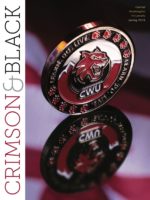Here’s the story:
On the morning of Thursday, May 9, 1912, M.E. Root, who worked for Ellensburg contractor Edward C. Belch, unleashed a dynamite blast on a hillside on East Third Street on Craig’s Hill. Root’s task was to loosen “the cement rock” so Belch could excavate the site for construction of a 24-room apartment house.
As the dust cleared, Root noticed something shiny and white peeking from the ground. It was a human skull half-buried in the rock.
“No effort was made to molest the balance of the skeleton till later in the afternoon, when the small son of contractor Belch was told by his father of the discovery,” the Yakima Herald reported two days later. “With the aid of a pick, he uncovered the perfect skeleton.”
According to news accounts, the boy removed the bones so they could later be studied and identified.
Word of the find spread through Ellensburg, soon reaching John P. Munson, a professor of biological sciences at the Washington State Normal School. The dapper Munson was a Norwegian-American zoologist and educator who had written a textbook, Education Through Natural Study, and served as head of the school’s department of biology.
Eager to see these bones for himself, he visited the discovery site and while poking around “unearthed [another] skull that was broken up by the pick,” according to the newspaper. He studied the bones and pronounced that they were clearly those of a prehistoric Native American individual.
Munson noted that the teeth had a “peculiar formation” and indicated he thought it was because of “eating uncooked foods.” He noted the bones were “perfectly dry” and beneath a strata of shale rock that had preserved them. He estimated they were “many hundreds of years” in age.
The newspaper said the bones were uncovered 20 feet beneath the surface of the hill and the gravesites had apparently been tunneled into the hillside.
Dr. B.J. Moss, a local physician and the city health officer for Ellensburg, told the Herald that since the femur of the largest of the two skeletons was nearly 20 inches, that meant the prehistoric man was about 80 inches tall—or six-feet, eight-inches—because a man’s height is generally four times the length of the femur.
The article also said that one of the skulls was unusually large and had an upper jaw with two “complete and distinct rows of teeth in front, each set being perfectly formed. This was regarded as decidedly unusual by the Normal School professor, who examined the skull closely. He did not regard the two rows of teeth as a racial attribute, but rather as a freak of nature.”
The Herald story was quickly picked up and repackaged by dozens of other newspapers across the country. And like a game of telephone, the story was exaggerated at nearly each retelling.
The Morning Olympian noted, “At Ellensburg they have unearthed a primeval man skeleton with two rows of teeth, what an opportunity for the old-time dentists,” while the Evening Herald in Ottawa, Kansas, published a follow-up story with the headline, “Old Timer Must Have Been A Big Fellow.”
The Herald article quoted L.L. Sharp, chief of the General Land Office Field Division in Portland, Oregon, who claimed, “I just returned from Ellensburg, where I had an opportunity to view the bones. The skull jawbone, thigh, and other parts of the largest skeleton indicated a man to my mind at least eight feet high. A man of his stature and massive frame would weigh fully 300 pounds at the least.”
Sharp continued that he was convinced the bones were of a prehistoric race of giants who inhabited the region prior to the arrival of Native Americans.
Perhaps not surprisingly, the number of skeletons uncovered also grew in subsequent stories. The Seattle Post-Intelligencer reported that eleven skeletons, with sloping foreheads and two rows of teeth, had been discovered in Ellensburg. The story also said their jawbones were so large they would wrap around the face of a modern-day man.
Anthropological archaeologist Andy White, who teaches at the University of South Carolina and actively debunks accounts of alleged giants discovered throughout the U.S. in the 19th and early 20th centuries, noted in his research blog that one problem with the Ellensburg Giant story is how the femur bone was measured.
“If we assume that the femur measurement of 20 inches is accurate, it is possible to estimate the height of the individual using equations that are based on much more data than were available in the early 1900s,” he said. “It is reasonable to conclude that the original estimate of 6’8” was too high, as was the ‘to my mind’ estimate of 8’ provided by L.L. Sharp. The actual height of the individual was probably closer to 6’ or less.”
Additionally, White said the double row of teeth may simply have been teeth worn down by grinding.
“The phrase ‘double teeth all around’ was commonly used in the nineteenth century to describe individuals with such a high degree of tooth wear that it appeared as if all the teeth in the mouth were molars,” he said.
White’s conclusion?
“It was probably the remains of a relatively large individual, but it was not a ‘giant,’” he wrote. “The individual may have had some ‘extra’ anterior teeth, but more likely simply had a high degree of wear on his entire dentition. This was not unusual among prehistoric Native Americans.”
So, while CWU biology chair Munson, who was a well-respected academic who taught at the Normal School from 1899 to 1928 (and was the namesake for Munson Hall) was present for the discovery, he said there is no evidence the bones represented a race of prehistoric giants nor did he ever indicate 11 skeletons were uncovered.
There appear to be no records indicating the final resting place of the bones.



comments powered by Disqus